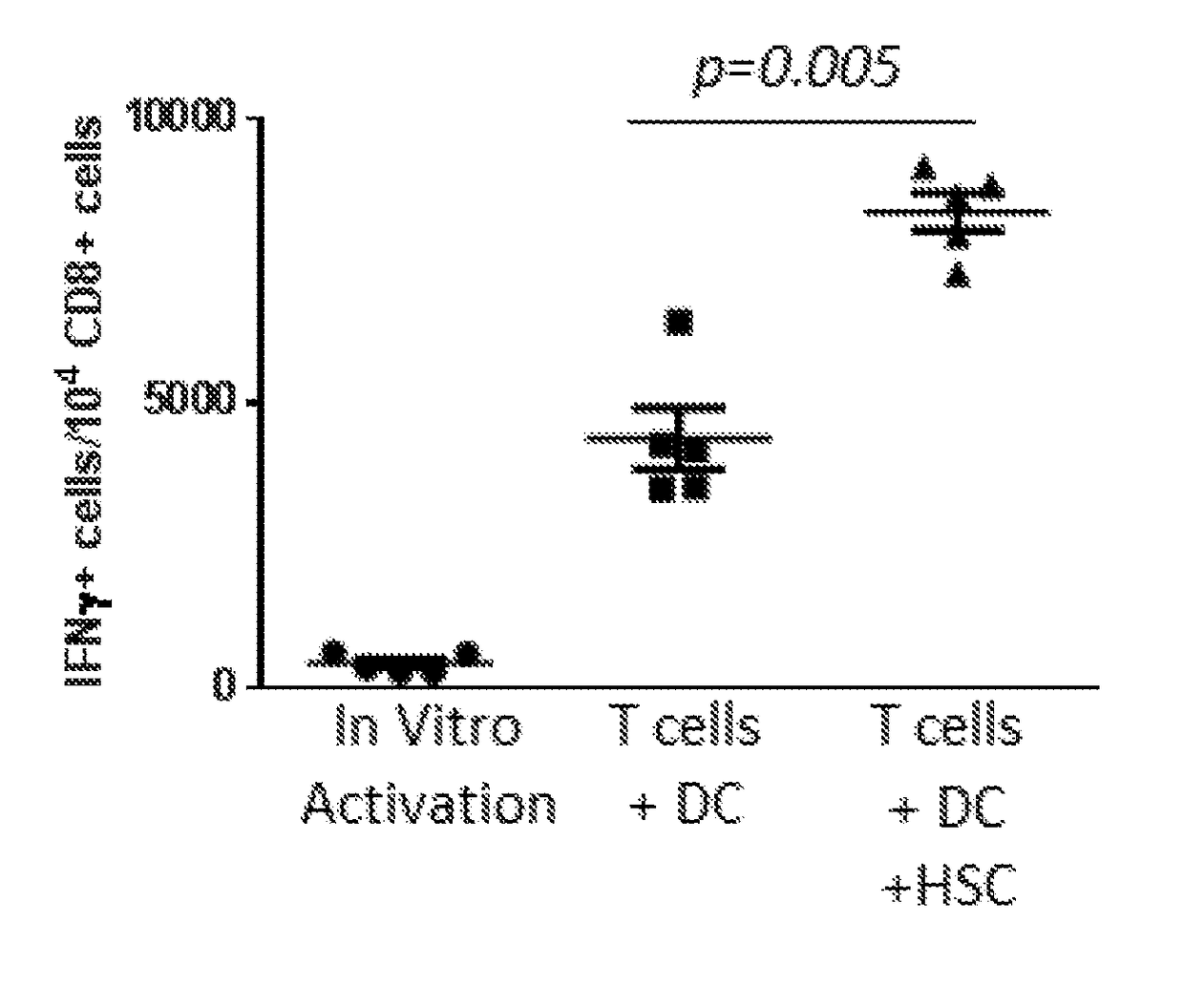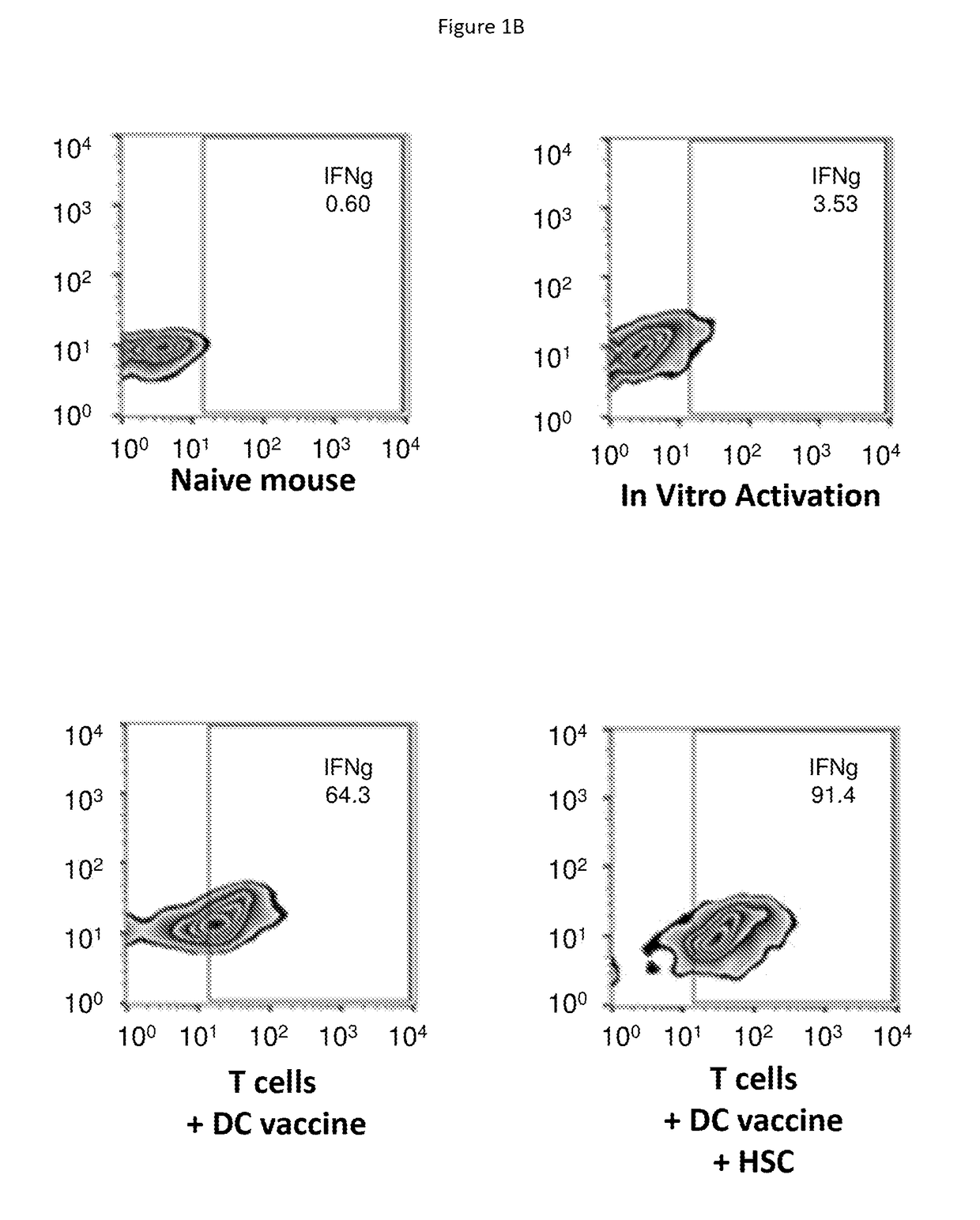Hematopoietic stem cells in combinatorial therapy with immune checkpoint inhibitors against cancer
a technology of immune checkpoint inhibitors and hematopoietic stem cells, which is applied in the direction of antibody medical ingredients, drug compositions, peptides, etc., can solve the problems that treatment alone does not produce immunologic or clinical effects, and achieve the effect of promoting the persistence and survival of activated interferon gamma
- Summary
- Abstract
- Description
- Claims
- Application Information
AI Technical Summary
Benefits of technology
Problems solved by technology
Method used
Image
Examples
example 1
Hematopoietic Stem Cells (HSCs) Alter Tumor-Draining Lymph Node Microenvironment and Enhance Anti-Tumor Immunity. HSC Transfer Leads to Increased IFNγ Secreting Anti-Tumor T Cells in Tumor Bearing Hosts
[0146]Adoptive cellular therapy (ACT) consisting of intravenous infusion of tumor-specific T cells and intradermal vaccination with dendritic cells was administered to mice bearing intracranial tumors with or without intravenous infusion of HSCs. T cells were derived from mice with yellow fluorescent protein (YFP) under control of an interferon-gamma promoter so that T cells fluoresced when activated. Tumor draining lymph nodes (cervical nodes) were collected from tumor bearing mice after ACT+ HSCs, RNA extracted, and examined by PCR array for the expression of a panel of T cell activation markers. The relative expression of genes in the +HSC lymph nodes is shown as a heat map in FIG. 1A. A marked increase in interferon gamma was noted as shown by the red square (D6 which is visible i...
example 2
Hematopoietic Stem Cells (HSCs) Alter Tumor Microenvironment and Restore Responsiveness to Immune Checkpoint Blockade. Combination of HSCs with Immune Checkpoint Inhibitors Potentiate Increased IFNγ Secretion by Tumor Infiltrating Host Cells
[0153]The observation that HSCs alter the microenvironment of lymph nodes and permit the increased activation of T cells as shown by IFNγ production, prompted us to examine the impact of HSC transfer on the tumor microenvironment and activation state of immune cells within intracranial tumors. The tumor microenvironment is known to be profoundly immunosuppressive leading to the shutdown of anti-tumor immune cells and failure of immunologic tumor rejection. We showed that HSC transfer alone leads to an increase in intratumoral IFNγ-secreted cells as shown in FIG. 2A&FIG. 2B. This increase was greater than that induced by anti-PD-1 monoclonal antibody PD1 blockade. However, HSC transfer alone or anti-PD-1 monoclonal antibody treatment alone were un...
example 3
Synergistic Effects of HSC Transfer and Immune Checkpoint Inhibitor Combination Therapy is Further Potentiated with Radiation Therapy
[0155]Immunocompetent C57BL / 6 mice received intracranial tumors, then divided into seven groups: Group 1: tumor only; Group 2: lineage negative hematopoietic stem cells (HSC); Group 3: anti-PD1 antibody (αPD1); Group 4: HSC+αPD1; Group 5: total body irradiation with 500 rads+HSC; Group 6: total body irradiation with 500 rads+αPD1; and Group 7: total body irradiation with 500 rads+HSC+αPD1. For total body irradiation, x-ray irradiation for a single dose of 500 rads was administered four days post-tumor implantation. For intravenous HSC administration, a single dose of 105 cells in sterile saline at a final volume of 100 ul was administered five days post-tumor implantation. For intraperitoneal αPD1, 10 mg / kg was administered every 5 days for a total of 4 doses, with starting dose at five days post-tumor implantation.
[0156]FIG. 5 shows results of the exp...
PUM
| Property | Measurement | Unit |
|---|---|---|
| volume | aaaaa | aaaaa |
| volume | aaaaa | aaaaa |
| volume | aaaaa | aaaaa |
Abstract
Description
Claims
Application Information
 Login to View More
Login to View More - R&D
- Intellectual Property
- Life Sciences
- Materials
- Tech Scout
- Unparalleled Data Quality
- Higher Quality Content
- 60% Fewer Hallucinations
Browse by: Latest US Patents, China's latest patents, Technical Efficacy Thesaurus, Application Domain, Technology Topic, Popular Technical Reports.
© 2025 PatSnap. All rights reserved.Legal|Privacy policy|Modern Slavery Act Transparency Statement|Sitemap|About US| Contact US: help@patsnap.com



